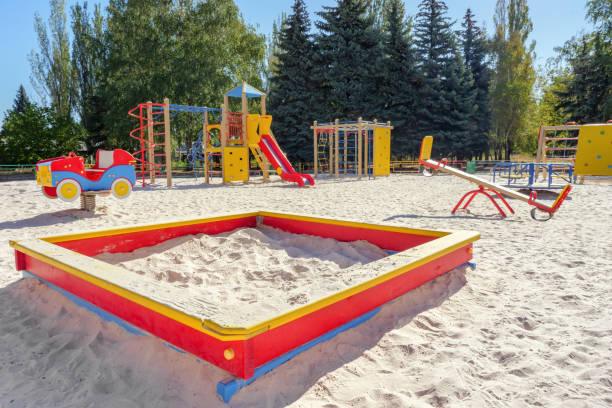Learn About Playground Equipment, Its Costs, and How It Balances Safety and Engagement
Playground equipment forms the foundation of childhood recreational spaces, offering children opportunities for physical activity, social interaction, and cognitive development. From traditional swings and slides to modern climbing structures and sensory panels, these carefully designed elements work together to create environments where children can explore, learn, and grow while having fun in safe, engaging settings.

Playgrounds serve as essential developmental spaces for children, combining physical challenges with opportunities for social growth and imaginative play. The equipment that populates these spaces represents a careful balance of safety considerations, developmental benefits, and engagement factors. Understanding the various types of playground equipment, their costs, and how they contribute to child development can help communities, schools, and families make informed decisions when creating or upgrading play spaces.
Introduction to Playground Equipment
Playground equipment encompasses a wide variety of structures and features designed specifically for children’s play and development. Traditional playground components include swings, slides, seesaws, and climbing frames, while modern playgrounds often incorporate more complex structures like rope courses, spinning equipment, and interactive panels. Each piece serves different developmental purposes—swings develop balance and coordination, climbing structures build upper body strength, and interactive panels enhance cognitive skills.
Equipment can be categorized by age appropriateness, with toddler areas featuring smaller, more accessible equipment with gentler slopes and lower heights. School-age playgrounds typically include more challenging components that promote advanced physical skills and risk assessment. Inclusive playground equipment, designed to accommodate children of all abilities, has become increasingly common, featuring wheelchair-accessible structures, sensory play elements, and equipment that can be enjoyed from multiple positions.
Playground Equipment Costs
The investment required for playground equipment varies significantly based on several factors including quality, materials, size, and installation requirements. For residential playgrounds, basic swing sets might cost between $300-$1,500, while elaborate backyard play structures can range from $2,000 to $10,000 or more. Commercial playground equipment for schools, parks, and public spaces represents a much larger investment, typically starting around $15,000 for basic setups and reaching $100,000+ for extensive, custom-designed play areas.
Material choice significantly impacts both cost and longevity. Wooden equipment tends to be less expensive initially but requires more maintenance over time. Metal components offer durability but can become hot in summer months. Plastic composite materials provide a balance of durability and safety but often at a higher initial cost. Additional expenses include safety surfacing (ranging from $5-$30 per square foot depending on the material), site preparation, installation labor, and ongoing maintenance.
| Equipment Type | Average Cost Range | Typical Lifespan | Maintenance Requirements |
|---|---|---|---|
| Basic Swing Set | $300-$1,500 | 7-10 years | Moderate |
| Commercial Play Structure | $15,000-$50,000 | 15-20 years | Low to Moderate |
| Custom Playground System | $50,000-$150,000+ | 15-25 years | Varies |
| Inclusive Playground | $80,000-$200,000+ | 15-20 years | Moderate |
| Safety Surfacing | $5-$30 per sq. ft. | 5-15 years | Low to High |
Prices, rates, or cost estimates mentioned in this article are based on the latest available information but may change over time. Independent research is advised before making financial decisions.
How Playground Equipment Balances Safety and Engagement
The most effective playground equipment achieves a delicate balance between safety and engagement—providing enough challenge to keep children interested while minimizing unnecessary risks. Safety considerations include age-appropriate height limitations, protective barriers, proper spacing between equipment, absence of entrapment hazards, and impact-absorbing surfacing. These safety elements are governed by standards established by organizations like the American Society for Testing and Materials (ASTM) and the Consumer Product Safety Commission (CPSC).
However, research indicates that playgrounds must also incorporate appropriate risk to be truly beneficial. Equipment that allows children to test their limits—climbing to manageable heights, experiencing controlled speed on slides, or navigating challenging obstacles—helps develop risk assessment skills and builds confidence. This concept of “beneficial risk” represents a shift from ultra-safe but unstimulating playgrounds toward thoughtfully designed equipment that engages children while keeping them reasonably protected.
Modern playground designers increasingly focus on creating equipment that satisfies both requirements—incorporating safety features like rounded edges, appropriate guardrails, and non-toxic materials while still providing varied levels of challenge through adjustable components, graduated difficulty levels, and equipment that can be used in multiple ways.
Pros of Getting the Right Playground Equipment
Selecting appropriate playground equipment yields numerous benefits for children, families, and communities. Well-chosen equipment promotes physical activity, helping combat childhood obesity and developing fundamental motor skills like balance, coordination, and strength. A 2018 study found that children who regularly use playground equipment demonstrated better physical fitness scores than those with limited access to such facilities.
Socially, playgrounds equipped with structures that encourage group interaction—such as multi-user swings, cooperative climbing elements, or dramatic play features—help children develop crucial social skills including sharing, negotiation, and conflict resolution. Equipment that accommodates multiple age groups allows siblings and children of varying ages to play together, strengthening community bonds.
From an economic perspective, investing in quality equipment initially often proves more cost-effective over time. Premium playground structures typically require less maintenance, experience fewer breakdowns, and last significantly longer than budget alternatives. Additionally, well-designed playgrounds increase property values and can become community gathering spaces that serve multiple generations.
Impact of Playground Equipment on Development
Playground equipment plays a crucial role in supporting various aspects of child development. Physical development benefits are perhaps the most obvious—climbing builds upper body strength, swinging develops core muscles and balance, and navigating play structures enhances gross motor coordination. However, the developmental impact extends far beyond physical growth.
Cognitively, playground equipment challenges children to solve problems, assess risks, and make decisions. Equipment with movable parts, puzzles, or cause-and-effect elements stimulates critical thinking and spatial awareness. Imaginative play is fostered through structures that can represent different scenarios—a platform might become a ship, castle, or space station depending on the child’s imagination.
Emotionally, mastering playground challenges builds self-confidence and resilience. When children conquer a climbing wall they previously found intimidating or successfully navigate a balance beam, they develop a sense of accomplishment that transfers to other areas of life. Equipment designed for cooperative play also helps children develop emotional intelligence as they negotiate turns, collaborate on games, and respond to others’ feelings.
For children with developmental differences or disabilities, specialized inclusive equipment can provide crucial sensory experiences, physical therapy opportunities, and social inclusion. Elements like textured panels, musical components, and equipment accessible from multiple positions ensure all children can participate in the developmental benefits of play.
Playground equipment, when thoughtfully selected and properly maintained, creates environments where children can develop physically, socially, cognitively, and emotionally. The investment in quality equipment pays dividends in children’s health, community cohesion, and developmental outcomes. By understanding the balance between safety and engagement, the range of equipment options available, and the associated costs, communities and families can create play spaces that serve children’s needs while providing lasting value.




